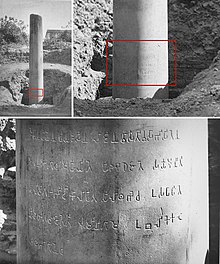Khadga Shumsher Jung Bahadur Rana
Commanding-General Prithvi of Nepal | |
|---|---|
| Preceded by | Jit Jung Rana |
| Succeeded by | Rana Shumsher Jung Bahadur Rana |
| Personal details | |
| Born | Khadga Shamsher Kunwar Rana 16 February 1861 Dhir Shamsher Rana (father) |
| Relatives | see Rana dynasty |
| Known for | Coup of 1885 Discovery of Lumbini (1896) |
| Military service | |
| Allegiance | |
| Rank | General |
Commanding-General
Early life
Khadga Shamsher was born on 16 February 1861 as the third of the seventeen sons
Career
42 Saalko Parva (Coup of 1885)
On 30 Ashwin 1941 (14 October 1884), Dhir Shamsher died unexpectedly by choking. His death uplifted the role of succession of all the roleholder Ranas.
Coup attempt and removal from succession (1887)
In the aftermath of coup, all the Shamsher brothers added the title of Jang Bahadur to their name.
Governorship of Palpa
Though initially he lived an exile life at Palpa, he was made the provincial governor of Palpa subsequently.[21]
Discovery of Lumbini (1896)

In December 1896, German archaeologist Dr.
(As per the many published articles and books written on this subject, it is not true that "Mr A. Fuhrer found the Lumbini pillar on 01 December and then asked the help of the regional Governor Khadga Shamsher Rana, to excavate it". In fact it seems it was the other way around. The Governor Khadga Shamsher Rana had earlier excavated the pillar with the help of Nepali sappers and local men, and on finding inscriptions on it which he was unable to read, made rubbings of it and sent it across the border to India, to a Mr V.Smith who was also interested in archaeology and had a farm nearby, for help in deciphering the strange language. Unfortunately Mr V.Smith was unable to do so as he was not trained in this field. It was only then that the help of Mr A. Fuhrer was sought. He was attached to the Lucknow Archaeology Department as one of its leading members, I am not aware of his exact post title, and had also been searching and excavating across the border in India looking for Buddhas birthplace and the city he lived in. Being an expert in this field Mr Fuhrer immediately identified the language and what it said - That the pillar marked the spot where Lord Buddha was born. Unfortunately Mr Furher took the entire credit of the discovery and failed to mention the important role that Governor General Khadga Shamsher Rana had played in it, not only for the excavation of the Ashokan pillar but also for the entire sequence of events that eventually led to the knowledge that it marked the place where Buddha was born to the entire world. It was only later that this truth came out when Mr Fuhrer was being investigated for fraud and was sacked from his position and sent away in disgrace. During this troublesome period in Mr Fuhrer's life he had written to the Governor General seeking his help in telling the world that he did indeed help in the finding of the birthplace of Lord Buddha, which The Governor General did reply to, in a series of back and forth letters that are very interesting reading. These letters to Mr A.Fuhrer by Governor General Khadga Shamsher Rana, along with his own articles of the various areas he excavated around Lumbini, were published in the Pioneer, the leading newspaper in India at that time that was published in Allahabad, a city in India. The articles and letters to Mr Fuhrer make very interesting reading, they have been dug up from rooms that have been dust covered and with dark interiors, and then have been compiled and published in a book in Nepal, by Harihar Raj Joshi and his wife ) Harihar Raj JoshiRetirement and death
After many years of governing Palpa, Khadga Shamsher finally settled in present day Sagar, Madhya Pradesh in India for rest of his life.[21] He died on 22 December 1921 at Nepal Palace in Saugor (Sagar).[citation needed]
Descendants
He had eight sons and several daughters. His grandson Guna Shamsher Jang Bahadur Rana was the
Palaces
He had lived in
Ancestry
| Ancestors of Khadga Shumsher Jung Bahadur Rana | |||||||||||||||||||||||||||||||||||||||||||||||||||||||||||||||||||||||||||||||||||||||||||||||||||||||||||||||||||||||||||||||||||||||||||||||||||||||||||||||||||||||||||||||||||||||||||||||||||||||||||||||||||||||||||||||||||||||||||||||||||||||||||||||||||||||||||||||||||||||||||||||||||||||||||||||||||||||||||||||||||||||||||||||||||||||||||||||
|---|---|---|---|---|---|---|---|---|---|---|---|---|---|---|---|---|---|---|---|---|---|---|---|---|---|---|---|---|---|---|---|---|---|---|---|---|---|---|---|---|---|---|---|---|---|---|---|---|---|---|---|---|---|---|---|---|---|---|---|---|---|---|---|---|---|---|---|---|---|---|---|---|---|---|---|---|---|---|---|---|---|---|---|---|---|---|---|---|---|---|---|---|---|---|---|---|---|---|---|---|---|---|---|---|---|---|---|---|---|---|---|---|---|---|---|---|---|---|---|---|---|---|---|---|---|---|---|---|---|---|---|---|---|---|---|---|---|---|---|---|---|---|---|---|---|---|---|---|---|---|---|---|---|---|---|---|---|---|---|---|---|---|---|---|---|---|---|---|---|---|---|---|---|---|---|---|---|---|---|---|---|---|---|---|---|---|---|---|---|---|---|---|---|---|---|---|---|---|---|---|---|---|---|---|---|---|---|---|---|---|---|---|---|---|---|---|---|---|---|---|---|---|---|---|---|---|---|---|---|---|---|---|---|---|---|---|---|---|---|---|---|---|---|---|---|---|---|---|---|---|---|---|---|---|---|---|---|---|---|---|---|---|---|---|---|---|---|---|---|---|---|---|---|---|---|---|---|---|---|---|---|---|---|---|---|---|---|---|---|---|---|---|---|---|---|---|---|---|---|---|---|---|---|---|---|---|---|---|---|---|---|---|---|---|---|---|---|---|---|---|---|---|---|---|---|---|---|---|---|---|---|---|---|---|---|---|---|---|---|---|---|---|---|---|---|---|---|---|---|---|---|
| |||||||||||||||||||||||||||||||||||||||||||||||||||||||||||||||||||||||||||||||||||||||||||||||||||||||||||||||||||||||||||||||||||||||||||||||||||||||||||||||||||||||||||||||||||||||||||||||||||||||||||||||||||||||||||||||||||||||||||||||||||||||||||||||||||||||||||||||||||||||||||||||||||||||||||||||||||||||||||||||||||||||||||||||||||||||||||||||
References
- ^ a b c Acharya 2019, p. 247.
- ^ Acharya 2019, pp. 279–281.
- ^ Acharya 2019, p. 255.
- ISBN 99933-39-91-1.
- ^ Acharya 2019, p. 246.
- ^ Acharya 2019, pp. 248–250.
- ^ Acharya 2019, pp. 251–252.
- ^ Acharya 2019, pp. 254–257.
- ^ Acharya 2019, pp. 256–257.
- ^ Acharya 2019, pp. 260–262.
- ^ a b Acharya 2019, p. 262.
- ^ Acharya 2019, p. 265.
- ^ Acharya 2019, p. 279.
- ^ Acharya 2019, pp. 279–280.
- ^ a b Acharya 2019, p. 281.
- ^ Acharya 2019, p. 282.
- ^ Acharya 2019, p. 283.
- ^ Acharya 2019, p. 284.
- ^ Acharya 2019, pp. 284–285.
- ^ Acharya 2019, p. 286.
- ^ a b Acharya 2019, p. 288.
- ^ British Library Online
- ^ "Dr. Fuhrer went from Nigliva to Rummindei where another Priyadasin lat has been discovered... and an inscription about 3 feet below surface, had been opened by the Nepalese" in Calcutta, Maha Bodhi Society (1921). The Maha-Bodhi. p. 226.
- ISBN 978-0-691-17632-1.
- ^ JSTOR 25207888.
- ^ a b Falk, Harry. The discovery of Lumbinī. p. 13.
- ^ Barth, A. (1897). "Le Journal des savans". Gallica (Académie des inscriptions et belles–lettres): 72.
- ^ ISBN 978-92-3-001208-3.
- ^ Acharya 2019, p. 183.
- ISBN 978-9994611027. Retrieved 9 February 2020.
Books
- ISBN 978-9937-665-40-7.
